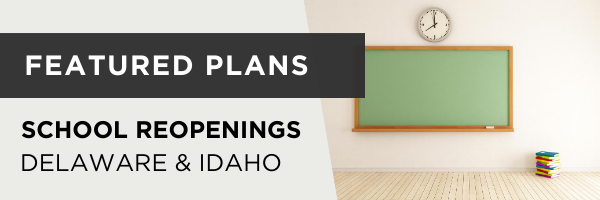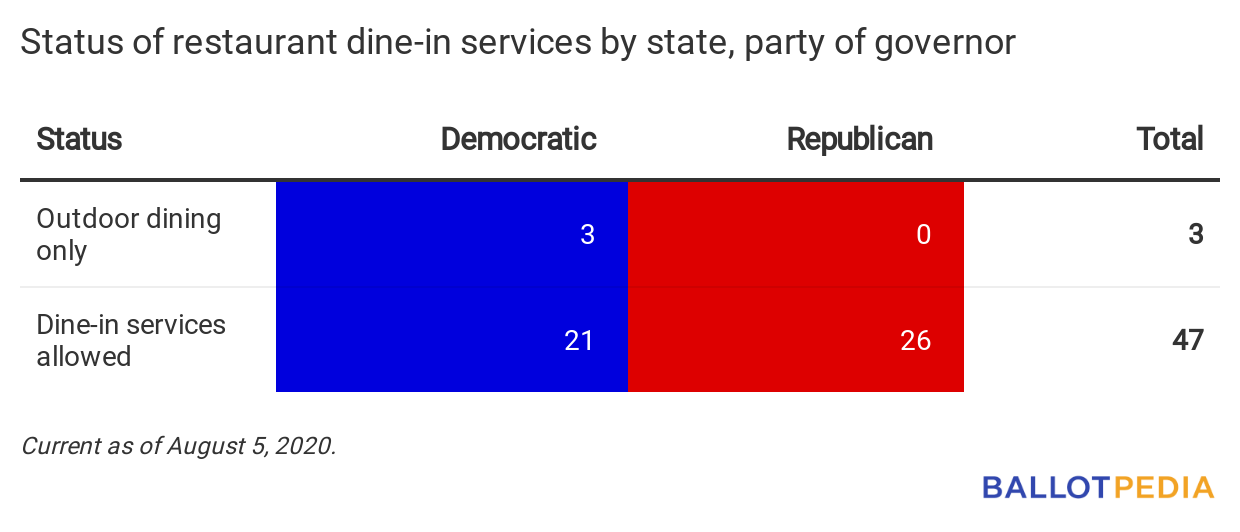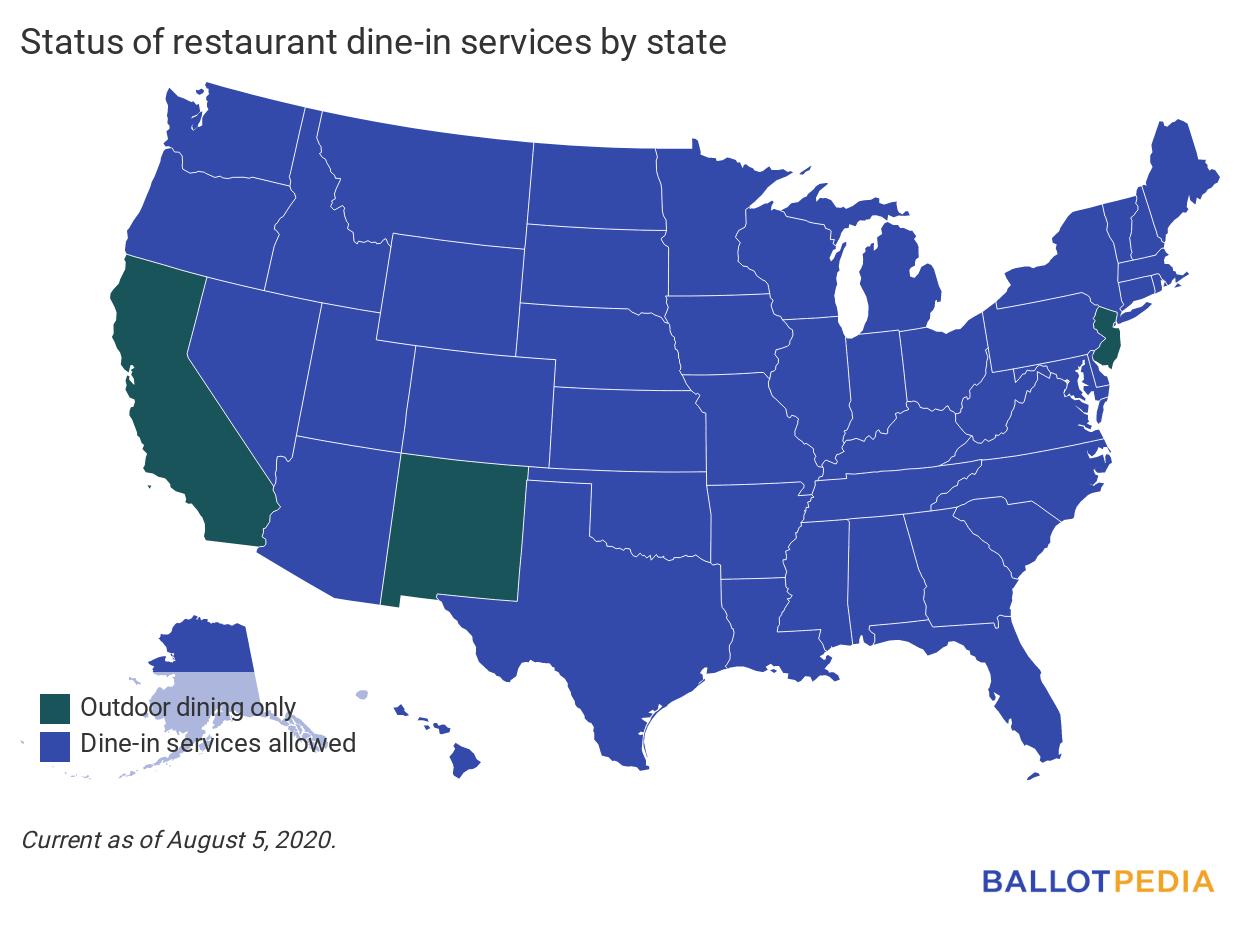
This is an in-depth summary of two state plans to reopen public K-12 schools for the 2020-2021 school year.
Delaware’s Returning to School plan
The Delaware Department of Education published its school reopening guidance on July 15. Secretary of Education Susan Bunting said, “This guidance document is meant to be used as support for district and charter leaders as they continue planning for the opening of the 2020-2021 school year. Essential safety protocols must be implemented by all Delaware schools, PreK-12. Additionally, actionable planning steps have been included for districts and charter schools to consider as they develop their own site-based plans.”
Delaware does not have a statewide date to reopen public schools, but Gov. John Carney (D) is expected to announce how schools will resume operations later in August, depending on the community spread of the coronavirus. According to EdWeek, public schools in Delaware traditionally start the academic year between Aug. 22 and Sept. 9.
On March 13, Carney closed schools from March 16 to March 27. On March 23, Carney extended the closure to May 15. The governor closed schools for the rest of the academic year on April 24.
Context
Delaware is a Democratic trifecta. The governor is a Democrat, and Democrats have majorities in both chambers of the state legislature. The state became a Democratic trifecta in 2009.
The following tables show public education statistics in Delaware, including a rank comparing it to the other 49 states. Rank one is the highest number of each figure, rank 50 is the lowest. All data comes from the Common Core of Data provided by the National Center for Education Statistics.
| Delaware public school metrics |
| Category |
Figure |
50-state rank |
| Per pupil spending (’16-’17) |
$16,490 |
14 |
| Number of students (’18-’19) |
138,405 |
46 |
| Number of teachers (’16-17) |
9,208 |
47 |
| Number of public schools (’18-’19) |
227 |
50 |
| Student:teacher ratio (’18-’19) |
14.4 |
32 |
| Percent qualifying for free/reduced lunch (’16-’17) |
48.1% |
22 |
| Delaware public school revenue |
| Category |
Figure |
50-state rank |
| Total revenue |
$2,077,887,000 |
45 |
| Percent from federal sources |
8.7% |
28 |
| Percent from state sources |
57.7% |
12 |
| Percent from local sources |
33.6% |
35 |
Details
District reopening plans
The document does not specifically require schools to develop individual reopening plans for approval or publishing. Schools are required to follow the state’s minimum basic requirements. Districts are encouraged to develop plans for three possible situations, based on the document’s guidance: Scenario 1 (minimal community spread), Scenario 2 (minimal-to-moderate community spread), and Scenario 3 (significant community spread).
In-person, hybrid, and online learning
The plan calls for fully in-person, hybrid, or fully remote classes, depending on the state’s rate of community spread. In Scenario 1, schools are open to fully in-person operations. Scenario 2 allows schools and districts to use a hybrid model to minimize contact and exposure. School buildings are not permitted to open in Scenario 3 and all learning must be conducted remotely. Later in August, Gov. Carney will announce which Scenario schools will need to use and if there are any regional differences in the state’s approach to reopening.
Mask requirements
All staff and students in grades 4-12 are required to wear masks in school buildings. The document recommends that students in pre-K through third grade also wear masks.
In-person health recommendations and requirements
The plan contains the following general safety guidelines for in-person operations:
| “ |
- Social distancing:
- Students and staff should maintain the recommended distance of 6 feet or greater between individuals and must maintain a minimum of 3 feet apart with face coverings, including when seated at desks or standing in classrooms.
- Individual desks should be used, reducing or eliminating shared table seating, to the extent practicable. When tables have to be shared, students should be seated the recommended 6 feet or greater between individuals and must be a minimum of 3 feet apart with face coverings.
- Desks must be arranged so they are facing the same direction.
- Hallways or corridors should flow either in one direction only or, if not possible, one direction on each side of the hallway with ample 6 feet of distance between students in single file flow on each side.
- In group classes without tables, such as physical education, teachers should design activities that allow for social distancing.
- Minimizing mixing and contact:
- Students should be kept in stable groups throughout the day with little to no mixing of classes.
- Families, outside visitors, and others entering the school should be as limited as absolutely possible. Adults who are assigned to work at the school, such as student teachers or before- and after-school staff, may be allowed as needed.
- Off-site field trips must be discontinued.
- Large-scale gatherings of more than 50 people should be avoided. Attendees at large-scale gatherings must be able to maintain 6 feet of social distancing at all times from non-household members.
- Health status and monitoring:
- Students and staff must stay home if they are exhibiting any symptoms of COVID-19 or have been confirmed to have COVID-19 or if required by DPH to isolate or quarantine.
- Students and/or their families should complete a health assessment every morning before leaving for school, to the extent practicable.
- Staff should also complete a health assessment every morning before leaving for school.
- Schools must identify an area or room separated from others where a student or staff member who becomes ill at school can wait until they can be picked up, which should be arranged as soon as possible, or transported to a medical facility if necessary.
- Testing educators and staff is a priority for the state. DDOE and DPH will work with all schools on how to make testing available and convenient. Additional guidance regarding testing is forthcoming.
|
” |
For more specific guidelines, click here (starting on page 7).
Transportation and busing requirements and restrictions
The document directs school districts and charter schools to implement the following general mitigation tactics on buses:
| “ |
- Capacity must be limited by the number of students that can be seated between 3 or more feet apart on the school bus with face coverings (one student per row in staggered fashion, if possible). Students from the same family may sit together in one row, however. All staff and students 4th grade and higher must wear face coverings except when doing so would inhibit the individual’s health.
- High-touch surfaces on buses (handrails, seat tops, particularly in first few rows) must be cleaned between every bus run with an EPA-approved solution.
- Windows should be open to allow ventilation, as weather permits.
|
” |
For more specific transportation guidelines, click here (starting on page 17).
Idaho’s Back-to-School Framework
On July 9, the Idaho Board of Education approved the Back-to-School Framework. The document says that it “outlines the expectations, support for local governance and decision-making, and guidance and best practices on the key operational components for safe reopening in the fall.”
The Framework replaced initial reopening guidelines that the Board had released on May 5 that was aligned with Gov. Butch Otter’s (R) reopening plan for the state as a whole.
Idaho does not have a statewide date for public schools to reopen. According to EdWeek, public schools in Idaho traditionally start the school year between late August and early September, with the exact start date varying by district.
On March 23, the board closed public schools across the state from March 24 to April 20. On April 6, the board closed public schools to in-person instruction for the remainder of the school year or until social distancing protocols in the state were lifted. Officials said that individual schools could be approved to reopen if local social distancing orders were lifted and the school met criteria laid out by the board.
Context
Idaho is a Republican trifecta. The governor is a Republican, and Republicans have majorities in both chambers of the state legislature. The state became a Republican trifecta in 1995.
The following tables show public education statistics in Idaho, including a rank comparing it to the other 49 states. Rank one is the highest number of each figure, rank 50 is the lowest. All data comes from the Common Core of Data provided by the National Center for Education Statistics.
| Idaho public school metrics |
| Category |
Figure |
50-state rank |
| Per pupil spending (’16-’17) |
$8,615 |
50 |
| Number of students (’18-’19) |
309,875 |
38 |
| Number of teachers (’16-17) |
16,204 |
39 |
| Number of public schools (’18-’19) |
759 |
38 |
| Student:teacher ratio (’18-’19) |
18.5 |
6 |
| Percent qualifying for free/reduced lunch (’16-’17) |
45.8% |
28 |
| Idaho public school revenue |
| Category |
Figure |
50-state rank |
| Total revenue |
$2,294,497,000 |
44 |
| Percent from federal sources |
10.7% |
16 |
| Percent from state sources |
65% |
6 |
| Percent from local sources |
24.3% |
46 |
Details
District reopening plans
Local school boards are responsible for developing plans and procedures for responding to the pandemic while providing student instruction. Local health districts are expected to advise these boards on health safety plans and procedures.
The framework does not specify whether plans have to be approved by the state or posted publicly for review.
In-person, hybrid, and online learning
Under the framework, local health districts will assign categories (levels) to schools based on the level of transmission within their community using criteria established in the statewide reopening plan. Each of those categories has a definition and recommended level of school operations.
| “ |
- Category 1: No Community Transmission
- Definitions: Evidence of isolated cases, case investigations underway, no evidence of exposure in large communal setting, e.g., healthcare facility, school, mass gathering.
- Level of Operations: School buildings open with physical distancing and sanitation
- Category 2: Minimal to Moderate Community Transmission
- Definitions: Widespread and/or sustained transmission with high likelihood or confirmed exposure within communal settings, with potential for rapid increase in suspected cases.
- Level of Operations: School buildings open but option of limited/staggered use of school buildings with physical distancing and sanitation
- Category 3: Substantial Community Transmission
- Definitions: Large-scale community transmission, healthcare staffing significantly impacted, multiple cases within communal settings like healthcare facilities, schools, mass gatherings, etc.
- Level of Operations: Targeted, short-term, or extended building closure
|
” |
Mask requirements
The framework provides recommendations on masks based on the category assigned by local health districts.
- Category 1: Masks recommended for students and staff but not required.
- Category 2: Masks recommended for students, staff, and visitors when practical.
- Category 3: If staff are allowed in the building, all staff must follow all Centers for Disease Control and Prevention guidelines on the use of masks. As of Aug. 5, those guidelines recommended that people wear masks in public settings.
In-person health recommendations and requirements
The framework provides health recommendations for use in all three categories of community spread for the following school operations: preventative measures, testing, student assessment, instruction, social emotional learning, at-risk populations, food service, transportation, and student athletics. To view specific recommendations and requirements in each area, click here.
Transportation and busing requirements and restrictions
Transportation recommendations are also based on the category of community spread.
- Category 1: Drivers and students are encouraged to wear masks.
- Category 2: Masks required for drivers and recommended for students. Utilize spaced seating and establish protocols for loading and unloading children from different households.
- Category 3: Limit transportation to small groups of students from the same family that need to go to school facilities to receive services. Mask requirements are not outlined in the framework.
Responses
On July 20, Idaho Education Association President Layne McInelly said:
| “ |
When school buildings across the state were closed this spring, the decision-making was based on science and data. That approach seems to have been abandoned in the rush to reopen schools this fall. Idaho is at or near the highest percentage growth in COVID-19 cases in the nation. That is a troubling backdrop for a rush to reopen schools where large numbers of people will be gathering, and health precautions will be difficult to achieve. |
” |
Additional activity
In this section, we feature examples of other federal, state, and local government activity, as well as influencers relevant to recovering from the pandemic.
- The University of Connecticut canceled its 2020 football season, becoming the first member of the Division 1 Football Bowl Subdivision to do so. “The safety challenges created by COVID-19 place our football student-athletes at an unacceptable level of risk,” said Athletic Director David Benedict.
- Chicago Public Schools will begin the school year with online-only classes. School officials said that meal delivery for at-risk students would continue and that free broadband would be expanded to up to 100,000 families.
- On Aug. 3, as the result of a challenge by New York Attorney General Letitia James (D), Judge J. Paul Oetken of the U.S. District Court for the Southern District of New York vacated portions of the U.S. Department of Labor’s (DOL) final rule implementing the Families First Coronavirus Response Act (FFCRA). The FFCRA mandates that certain employers provide paid emergency sick and/or family leave to employees who are unable to work due to mandated COVID-19 quarantine or symptoms. The mandate extends to parents and guardians in the event of school or childcare unavailability. New York argued that the DOL violated the Administrative Procedure Act (APA) because the final rule restricts eligibility under the FFCRA in a manner that is “not authorized by, and conflicts with, the FFCRA. New York further argued the rule exceeds the FFCRA’s statutory by imposing additional burdens on employees seeking to claim benefits. In so doing, New York argued, the DOL was responsible for denying “vital financial support and exposing millions of American workers and their communities to further transmission of infectious disease in the middle of a once-in-a-century pandemic.” Oetken vacated the final rule’s work-availability requirement, which made employees ineligible for leave under the FFCRA if their employer had no work for them because of COVID-related slowdowns or temporary closures. Oetken also struck down the DOL’s broad definition of a non-eligible health care provider, the requirement that an employee secure employer consent for intermittent leave, and the requirement that documentation is provided before taking leave. The remainder of the final rule was allowed to stand. Neither party has commented on the ruling, nor has the DOL indicated whether it will appeal or issue a new rule. Oetken is an appointee of Barack Obama (D).
|




